小学英语语法点整理
- 格式:doc
- 大小:21.00 KB
- 文档页数:6
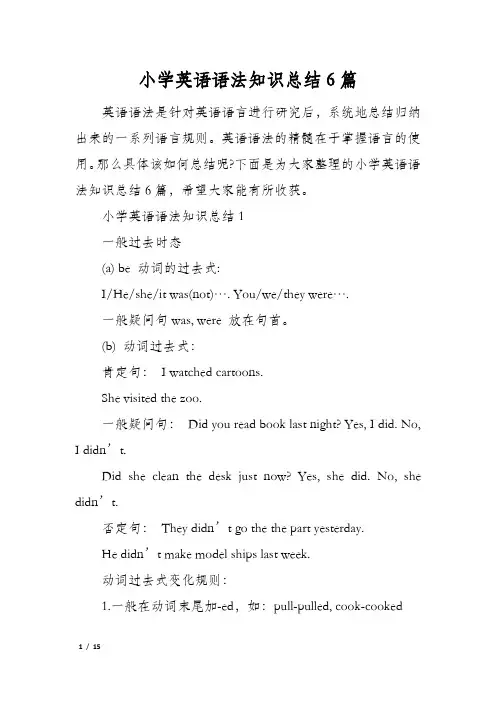
小学英语语法知识总结6篇英语语法是针对英语语言进行研究后,系统地总结归纳出来的一系列语言规则。
英语语法的精髓在于掌握语言的使用。
那么具体该如何总结呢?下面是为大家整理的小学英语语法知识总结6篇,希望大家能有所收获。
小学英语语法知识总结1一般过去时态(a) be 动词的过去式:I/He/she/it was(not)…. You/we/they were….一般疑问句was, were 放在句首。
(b) 动词过去式:肯定句:I watched cartoons.She visited the zoo.一般疑问句:Did you read book last night? Yes, I did. No, I didn’t.Did she clean the desk just now? Yes, she did. No, she didn’t.否定句:They didn’t go the the part yesterday.He didn’t make model ships last week.动词过去式变化规则:1.一般在动词末尾加-ed,如:pull-pulled, cook-cooked2.结尾是e加d,如:taste-tasted3.末尾是辅音字母加一个元音字母和一个辅音字母的重读闭音节,应双写末尾的辅音字母,再加-ed,如:stop-stopped4.以“辅音字母+y”结尾的,变y为i,再加-ed,如:study-studied5.不规则动词过去式:am,is-was,are-were,do-did,see-saw,say-said,give-gave,get-got,go-went,come-came,have-had,eat-ate,take-took,run-ran,sing-sang,put-put,make-made,read-read,write-wrote,draw-drew,drink-drank,swim-swam,sit-sat小学英语语法知识总结2动词加ing的变化规则1.一般情况下,直接加ing,如:cook-cooking2.以不发音的e结尾,去e加ing,如:make-making, taste-tasting3.如果末尾是辅音字母加一个元音字母和一个辅音字母,双写末尾的辅音字母,再加ing,如:run-running, stop-stopping 现在进行时,用来表示正在进行或发生的动作。
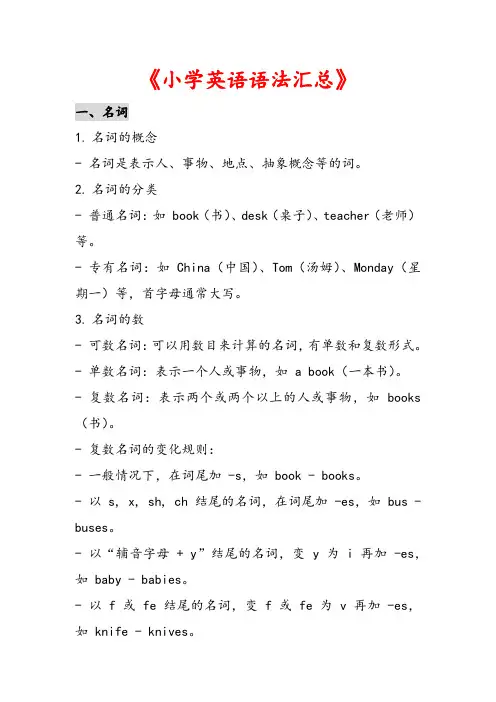
《小学英语语法汇总》一、名词1.名词的概念- 名词是表示人、事物、地点、抽象概念等的词。
2.名词的分类- 普通名词:如 book(书)、desk(桌子)、teacher(老师)等。
- 专有名词:如 China(中国)、Tom(汤姆)、Monday(星期一)等,首字母通常大写。
3.名词的数- 可数名词:可以用数目来计算的名词,有单数和复数形式。
- 单数名词:表示一个人或事物,如 a book(一本书)。
- 复数名词:表示两个或两个以上的人或事物,如 books (书)。
- 复数名词的变化规则:- 一般情况下,在词尾加 -s,如 book - books。
- 以 s, x, sh, ch 结尾的名词,在词尾加 -es,如 bus - buses。
- 以“辅音字母 + y”结尾的名词,变 y 为 i 再加 -es,如 baby - babies。
- 以 f 或 fe 结尾的名词,变 f 或 fe 为 v 再加 -es,如 knife - knives。
- 不可数名词:不能用数目来计算的名词,如 water(水)、milk(牛奶)、rice(米饭)等。
不可数名词没有复数形式。
4.名词的所有格- 表示所属关系,有两种形式:- ’s 所有格:一般用于有生命的名词后,如 Tom’s book (汤姆的书)。
- of 所有格:一般用于无生命的名词后,如 the door of the classroom(教室的门)。
二、代词1.代词的概念- 代词是用来代替名词或名词短语的词。
2.代词的分类- 人称代词:表示“我”“你”“他”“她”“它”“我们”“你们”“他们”等的词。
- 主格:I(我)、you(你;你们)、he(他)、she(她)、it(它)、we(我们)、they(他们),在句子中作主语。
- 宾格:me(我)、you(你;你们)、him(他)、her(她)、it(它)、us(我们)、them(他们),在句子中作宾语。
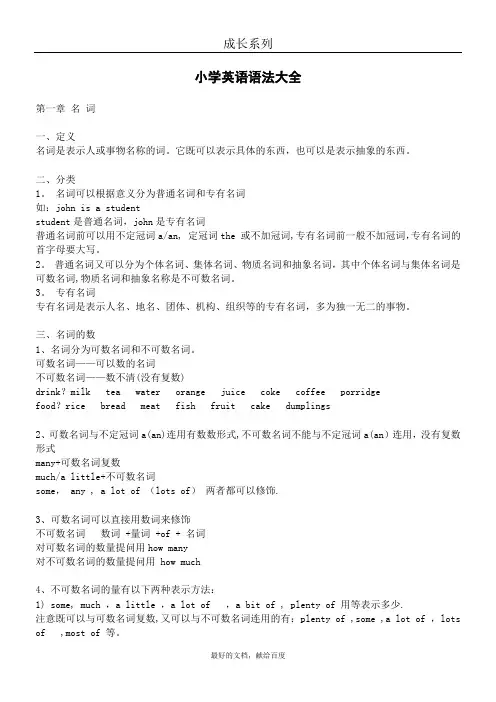
小学英语语法大全第一章名词一、定义名词是表示人或事物名称的词。
它既可以表示具体的东西,也可以是表示抽象的东西。
二、分类1。
名词可以根据意义分为普通名词和专有名词如:john is a studentstudent是普通名词,john是专有名词普通名词前可以用不定冠词a/an, 定冠词the 或不加冠词,专有名词前一般不加冠词,专有名词的首字母要大写。
2。
普通名词又可以分为个体名词、集体名词、物质名词和抽象名词,其中个体名词与集体名词是可数名词,物质名词和抽象名称是不可数名词。
3。
专有名词专有名词是表示人名、地名、团体、机构、组织等的专有名词,多为独一无二的事物。
三、名词的数1、名词分为可数名词和不可数名词。
可数名词——可以数的名词不可数名词——数不清(没有复数)drink?milk tea water orange juice coke coffee porridgefood?rice bread meat fish fruit cake dumplings2、可数名词与不定冠词a(an)连用有数数形式,不可数名词不能与不定冠词a(an)连用,没有复数形式many+可数名词复数much/a little+不可数名词some, any , a lot of (lots of)两者都可以修饰.3、可数名词可以直接用数词来修饰不可数名词数词 +量词 +of + 名词对可数名词的数量提问用how many对不可数名词的数量提问用 how much4、不可数名词的量有以下两种表示方法:1) some, much ,a little ,a lot of ,a bit of , plenty of 用等表示多少.注意既可以与可数名词复数,又可以与不可数名词连用的有:plenty of ,some ,a lot of ,lots of ,most of 等。
如there is much water in the bottle 。
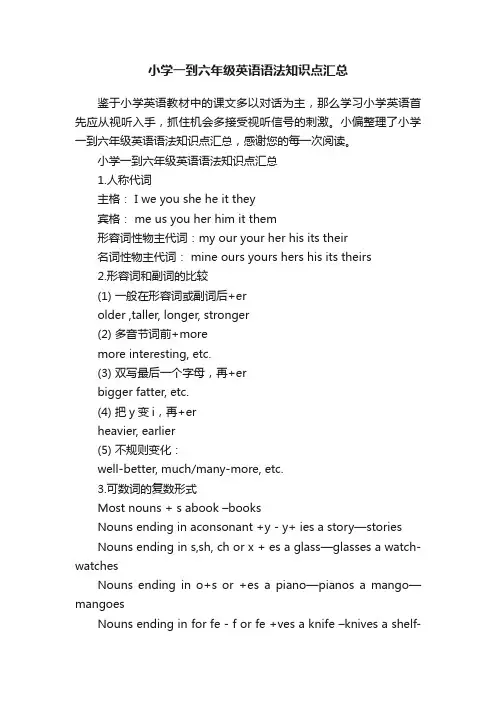
小学一到六年级英语语法知识点汇总鉴于小学英语教材中的课文多以对话为主,那么学习小学英语首先应从视听入手,抓住机会多接受视听信号的刺激。
小偏整理了小学一到六年级英语语法知识点汇总,感谢您的每一次阅读。
小学一到六年级英语语法知识点汇总1.人称代词主格: I we you she he it they宾格: me us you her him it them形容词性物主代词:my our your her his its their名词性物主代词: mine ours yours hers his its theirs2.形容词和副词的比较(1) 一般在形容词或副词后+erolder ,taller, longer, stronger(2) 多音节词前+moremore interesting, etc.(3) 双写最后一个字母,再+erbigger fatter, etc.(4) 把y变i,再+erheavier, earlier(5) 不规则变化:well-better, much/many-more, etc.3.可数词的复数形式Most nouns + s abook –booksNouns ending in aconsonant +y - y+ ies a story—storiesNouns ending in s,sh, ch or x + es a glass—glasses a watch-watchesNouns ending in o+s or +es a piano—pianos a mango—mangoesNouns ending in for fe - f or fe +ves a knife –knives a shelf-shelves4.不可数名词(单复数不变)bread, rice, water ,juice等。
5.缩略形式I’m= I a,you’re = you are,she’s= she is,he’s = he isit’s= it is,who’s =who is,can’t =can not,isn’t=is not等。
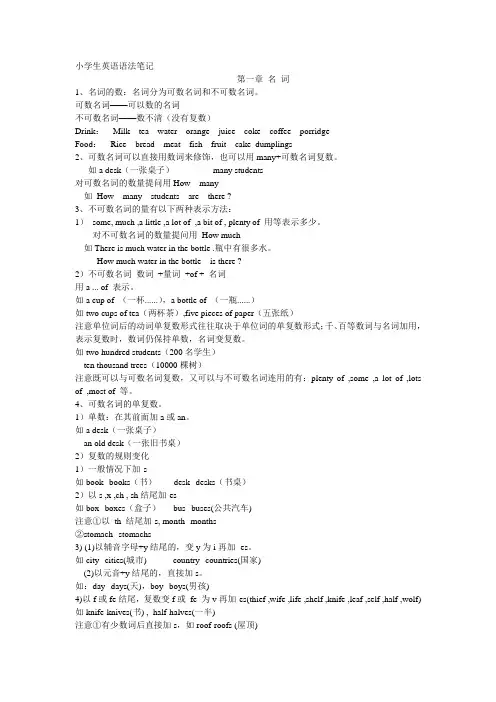
小学生英语语法笔记第一章名词1、名词的数:名词分为可数名词和不可数名词。
可数名词——可以数的名词不可数名词——数不清(没有复数)Drink:Milk tea water orange juice coke coffee porridgeFood:Rice bread meat fish fruit cake dumplings2、可数名词可以直接用数词来修饰,也可以用many+可数名词复数。
如a desk(一张桌子)many students对可数名词的数量提问用How many如How many students are there ?3、不可数名词的量有以下两种表示方法:1)some, much ,a little ,a lot of ,a bit of , plenty of 用等表示多少。
对不可数名词的数量提问用How much如There is much water in the bottle .瓶中有很多水。
How much water in the bottle is there ?2)不可数名词数词+量词+of + 名词用a ... of 表示。
如a cup of (一杯......),a bottle of (一瓶......)如two cups of tea(两杯茶),five pieces of paper(五张纸)注意单位词后的动词单复数形式往往取决于单位词的单复数形式;千、百等数词与名词加用,表示复数时,数词仍保持单数,名词变复数。
如two hundred students(200名学生)ten thousand trees(10000棵树)注意既可以与可数名词复数,又可以与不可数名词连用的有:plenty of ,some ,a lot of ,lots of ,most of 等。
4、可数名词的单复数。
1)单数:在其前面加a或an。
如a desk(一张桌子)an old desk(一张旧书桌)2)复数的规则变化1)一般情况下加-s如book--books(书)desk--desks(书桌)2)以s ,x ,ch , sh结尾加-es如box--boxes(盒子)bus--buses(公共汽车)注意①以th 结尾加-s, month--months②stomach--stomachs3) (1)以辅音字母+y结尾的,变y为i再加- es。
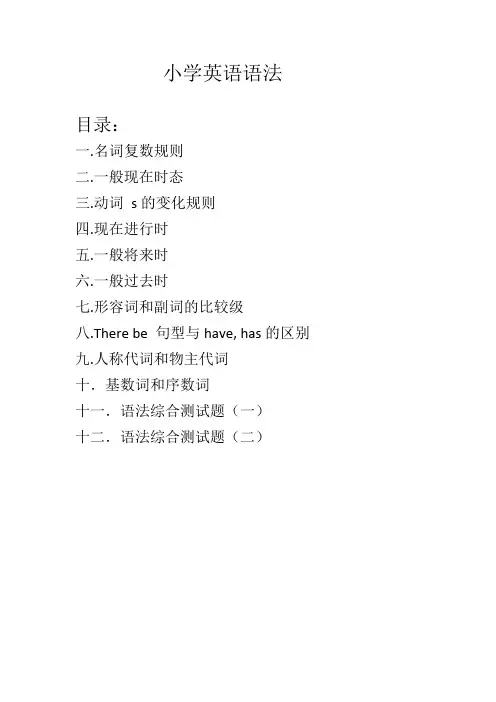
小学英语语法目录:一.名词复数规则二.一般现在时态三.动词s的变化规则四.现在进行时五.一般将来时六.一般过去时七.形容词和副词的比较级八.There be 句型与have, has的区别九.人称代词和物主代词十.基数词和序数词十一.语法综合测试题(一)十二.语法综合测试题(二)第一课时名词复数规则1.一般情况下,直接加-s,如:book-books, bag-bags, cat-cats, bed-beds2.以s. x. sh. ch结尾,加-es, 如:bus-buses, box-boxes, brush-brushes, watch-watches3.以“辅音字母y”结尾,变y为i, 再加-es,如:family-families, strawberry-strawberries4.以“f或fe”结尾,变f或fe为v, 再加-es,如:knife-knives leaf——leaves5.不规则名词复数:man-men woman-women child-children foot-feet tooth-teeth fish-fish people-people sheep-sheep Chinese-Chinese Japanese-Japanese写出下列各词的复数I _____ him ____ this _______ her ____ watch ___ child ____ photo ___ diary ___ day______ foot_____ book_____ dress ____ tooth____ sheep ____ box_____ strawberry _____ thief _____ you _____ peach___ sandwich ___ man_____ woman___第二课时一般现在时一般现在时基本用法介绍:一般现在时的功能1.表示事物或人物的特征、状态。
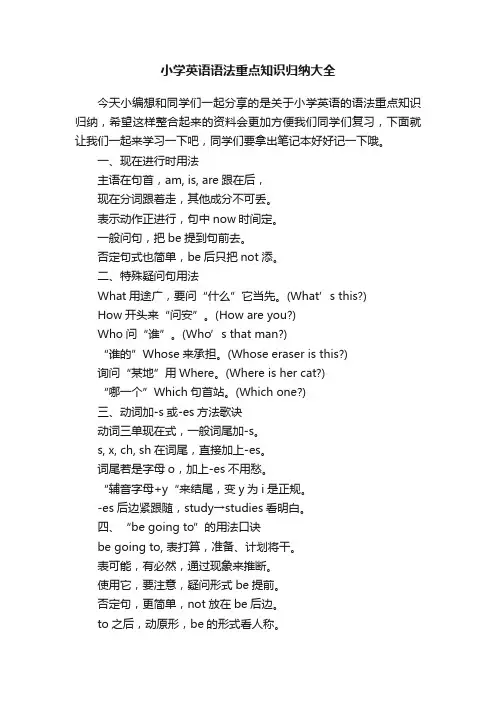
小学英语语法重点知识归纳大全今天小编想和同学们一起分享的是关于小学英语的语法重点知识归纳,希望这样整合起来的资料会更加方便我们同学们复习,下面就让我们一起来学习一下吧,同学们要拿出笔记本好好记一下哦。
一、现在进行时用法主语在句首,am, is, are跟在后,现在分词跟着走,其他成分不可丢。
表示动作正进行,句中now时间定。
一般问句,把be提到句前去。
否定句式也简单,be后只把not添。
二、特殊疑问句用法What用途广,要问“什么”它当先。
(What’s this?)How开头来“问安”。
(How are you?)Who问“谁”。
(Who’s that man?)“谁的”Whose来承担。
(Whose eraser is this?)询问“某地”用Where。
(Where is her cat?)“哪一个”Which句首站。
(Which one?)三、动词加-s或-es方法歌诀动词三单现在式,一般词尾加-s。
s, x, ch, sh在词尾,直接加上-es。
词尾若是字母o,加上-es不用愁。
“辅音字母+y“来结尾,变y为i是正规。
-es后边紧跟随,study→studies看明白。
四、“be going to”的用法口诀be going to, 表打算,准备、计划将干。
表可能,有必然,通过现象来推断。
使用它,要注意,疑问形式be提前。
否定句,更简单,not放在be后边。
to之后,动原形,be的形式看人称。
下列词,要注意,come go和离去(leave)进行时,表将来,牢牢记住莫忘记。
小学英语知识重点一、形容词性物主代词1、形容词性物主代词8个:My your his her its our your their我的你的他的她的它的我们的你们的他(她、它)们的2、形容词性物主代词的特点:1)译成汉语都有"的" eg:my 我的 their 他们的2)后面加名词:eg:my backpack his name3)前后不用冠词 a an theThis is a my eraser(错误)That is your a pen(错误)It's his the pen(错误)3、I(物主代词)my you(物主代词)your he (物主代词)her we (物主代词) our注:在变物主代词时,把原题所给的词加上的,再译成单词就可以了。

(超详)小学英语知识点归纳汇总
1. 语法知识点
- 主谓一致:主语和谓语动词在人称和数上保持一致。
- 形容词和副词的比较级和最高级:用于比较两个或多个事物的形容词和副词的变化形式。
- 名词的单复数:名词变化形式表示单数或复数。
- 时态:表示动作发生的时间,包括现在时、过去时和将来时等。
2. 词汇知识点
- 常用的基础词汇:包括数字、颜色、家庭成员、动物、食物等基本词汇。
- 动词:常用的动词及其过去式和现在分词形式。
- 名词:常见的名词及其单数和复数形式。
- 形容词和副词:用于描述事物的形容词和表示方式的副词。
3. 句型知识点
- 祈使句:用于表达命令、请求或建议的句子。
- 选择疑问句:用于提问时给出的选择项。
- 陈述句:陈述一个事实或描述一个情况的句子。
- 疑问句:用于提出问题的句子。
4. 阅读知识点
- 词义猜测:通过上下文推测词语的意思。
- 主旨理解:理解文章的中心思想或要点。
- 细节理解:理解文章中的具体细节信息。
- 推理判断:根据已有信息推断出未提及的信息。
以上是小学英语的一些基本知识点归纳汇总,希望对您有帮助!。
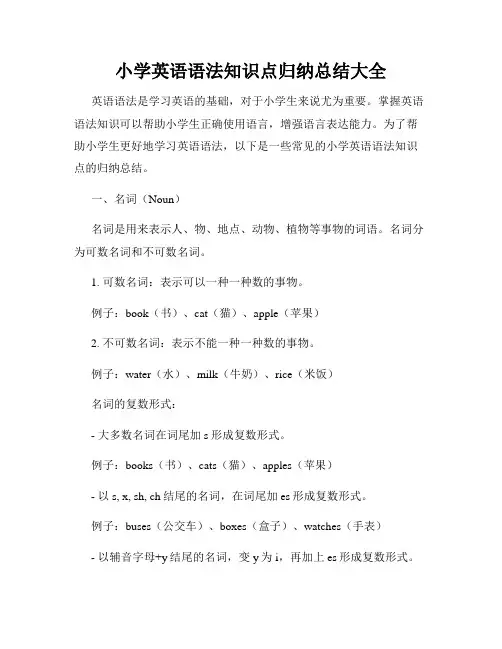
小学英语语法知识点归纳总结大全英语语法是学习英语的基础,对于小学生来说尤为重要。
掌握英语语法知识可以帮助小学生正确使用语言,增强语言表达能力。
为了帮助小学生更好地学习英语语法,以下是一些常见的小学英语语法知识点的归纳总结。
一、名词(Noun)名词是用来表示人、物、地点、动物、植物等事物的词语。
名词分为可数名词和不可数名词。
1. 可数名词:表示可以一种一种数的事物。
例子:book(书)、cat(猫)、apple(苹果)2. 不可数名词:表示不能一种一种数的事物。
例子:water(水)、milk(牛奶)、rice(米饭)名词的复数形式:- 大多数名词在词尾加s形成复数形式。
例子:books(书)、cats(猫)、apples(苹果)- 以s, x, sh, ch结尾的名词,在词尾加es形成复数形式。
例子:buses(公交车)、boxes(盒子)、watches(手表)- 以辅音字母+y结尾的名词,变y为i,再加上es形成复数形式。
例子:babies(婴儿)、flies(苍蝇)、berries(浆果)二、代词(Pronoun)代词是用来代替名词的词语。
代词可以分为主格代词、宾格代词和物主代词。
1. 主格代词:在句子中担任主语的代词。
例子:I(我)、you(你)、he(他)2. 宾格代词:在句子中担任宾语的代词。
例子:me(我)、you(你)、him(他)3. 物主代词:表示所属关系的代词。
例子:my(我的)、your(你的)、his(他的)三、动词(Verb)动词是表示动作、状态或存在的词语。
动词分为及物动词和不及物动词。
1. 及物动词:需要接宾语来完成意义的动词。
例子:eat(吃)、drink(喝)、watch(观看)2. 不及物动词:不需要接宾语就能完成意义的动词。
例子:run(跑)、sleep(睡觉)、sit(坐)动词的时态:- 一般现在时:表示经常性或习惯性的动作。
例子:I eat breakfast every morning.(我每天早上吃早餐。
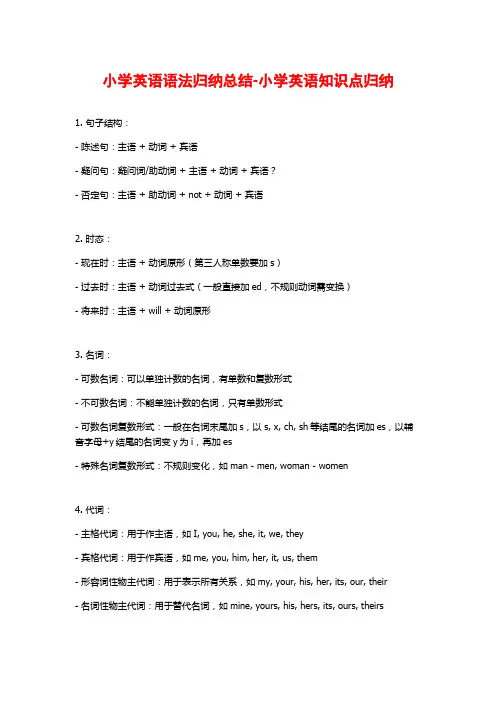
小学英语语法归纳总结-小学英语知识点归纳1. 句子结构:- 陈述句:主语 + 动词 + 宾语- 疑问句:疑问词/助动词 + 主语 + 动词 + 宾语?- 否定句:主语 + 助动词 + not + 动词 + 宾语2. 时态:- 现在时:主语 + 动词原形(第三人称单数要加s)- 过去时:主语 + 动词过去式(一般直接加ed,不规则动词需变换)- 将来时:主语 + will + 动词原形3. 名词:- 可数名词:可以单独计数的名词,有单数和复数形式- 不可数名词:不能单独计数的名词,只有单数形式- 可数名词复数形式:一般在名词末尾加s,以s, x, ch, sh等结尾的名词加es,以辅音字母+y结尾的名词变y为i,再加es- 特殊名词复数形式:不规则变化,如man - men, woman - women4. 代词:- 主格代词:用于作主语,如I, you, he, she, it, we, they- 宾格代词:用于作宾语,如me, you, him, her, it, us, them- 形容词性物主代词:用于表示所有关系,如my, your, his, her, its, our, their- 名词性物主代词:用于替代名词,如mine, yours, his, hers, its, ours, theirs5. 动词:- 基本动词:表示基本动作或状态的词汇,如play, run, eat- 助动词:用来辅助构成时态、人称、语态等形式,如be, do, have- 行为动词与非行为动词:行为动词表示具体的行动,如swim, dance,非行为动词表示状态或感觉,如like, love6. 形容词和副词:- 形容词:描述名词的词,用于修饰名词,一般放在名词前面,如big, small- 副词:描述动词、形容词或其他副词的词,用于修饰动词、形容词或其他副词,一般放在动词或形容词前面,如quickly, well7. 介词:- 介词的作用是连接名词或代词与其他词语,表示一种关系,如in, on, under8. 连词:- 并列连词:用于连接并列的词、短语或句子,如and, but, or- 从属连词:用于引导从句,如because, if, when以上是小学英语语法的基本知识点的归纳总结。
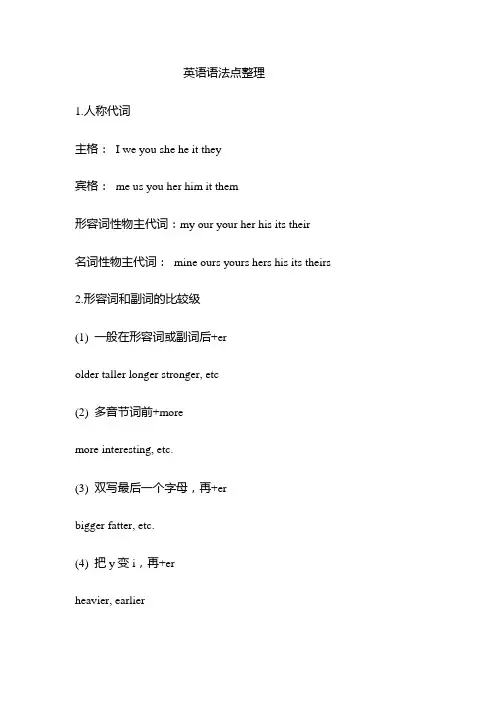
英语语法点整理1.人称代词主格:I we you she he it they宾格:me us you her him it them形容词性物主代词:my our your her his its their名词性物主代词:mine ours yours hers his its theirs 2.形容词和副词的比较级(1) 一般在形容词或副词后+erolder taller longer stronger, etc(2) 多音节词前+moremore interesting, etc.(3) 双写最后一个字母,再+erbigger fatter, etc.(4) 把y变i,再+erheavier, earlier(5) 不规则变化:well-better, much/many-more, etc.3.可数词的复数形式Most nouns + s a book –booksNouns ending in a consonant +y - y+ ies a story—storiesNouns ending in s, sh, ch or x + es a glass—glasses a watch-watches Nouns ending in o +s or +es a piano—pianos a mango—mangoes Nouns ending in f or fe - f or fe +ves a knife –knives a shelf-shelves 4.不可数名词(单复数形式不变)bread, rice, water ,juice etc.5. 缩略形式I’m = I am you’re = you are she’s = she is he’s = he isit’s = it is who’s =who is can’t =can not isn’t=is not etc6. a/ana book, a peachan egg an hour7. Preposition:on, in ,in front of, between, next to, near, beside, at, behind. 表示时间:at six o’clock, at Christmas, at breakfaston Monday on 15th July On National Dayin the evening in December in winter8. 基数词和序数词one – first two-second twenty-twentieth9. Some /anyI have some toys in my bedroom.Do you have any brothers or sisters?10. be 动词(1) Basic form: am/are/is(2) 肯定和否定句I am(not) from London.My eyes are(not) small.My hair is(not) long.(3)一般疑问句:Am I a Chniese? Yes, you are. No, you aren’t. Are they American? Yes, they are. No, they aren’t.Is the cat fat? Yes, it is. No, it isn’t.11. there be 结构肯定句:There is a …There are …一般疑问句:Is there …? Yes, there is./ No, there isn’t.Are there…? Yes, there are. /No, there aren’t.否定句:There isn’t …. There aren’t….12. 祈使句Sit down pleaseDon’t sit down, please.13. 现在进行时.通常用“now”.形式:be + verb +ingeg: I am(not) doing my homework.You/We/They are(not) reading.He/She/It is(not) eating.动词—ing 的形式Most verbs +ing walk—walkingVerbs ending in e -e + ing come—comingShort verbs ending in a vowel + a consonant run –running swim—swimming14 一般现在时。
【导语】英语语法是针对英语语⾔进⾏研究后,系统地总结归纳出来的⼀系列语⾔规则。
英语语法的精髓在于掌握语⾔的使⽤。
以下是⽆忧考整理的《⼩学英语语法知识点五篇》相关资料,希望帮助到您。
1.⼩学英语语法知识点 不可数名词(单复数形式不变) bread, rice, water ,juice etc. 缩略形式 I'm = I am you're = you are she's = she is he's = he is it's = it is who's =who is can't =can not isn't=is not etc a/an a book, a peach an egg an hour Preposition: on, in ,in front of, between, next to, near, beside, at, behind. 表⽰时间: at six o'clock, at Christmas, at breakfast on Monday on 15th July On National Day in the evening in December in winter 基数词和序数词 one - first two-second twenty-twentieth Some /any I have some toys in my bedroom. Do you have any brothers or sisters?2.⼩学英语语法知识点 (⼀)情态动词can can 在英语中有⼀个特殊的名字,叫做情态动词,表⽰“能够”, “会”, “能⼒”后⾯要跟着表⽰动作的动词。
没有时态和⼈称的变化。
表⽰不能做什么的时候,后⾯加上 not为can not,或者缩写为can’t。
问别⼈“能…吗?”要把can 放在句⼦前⾯,⾸字母要⼤写,句尾别忘加上问号。
小学英语时态语法重点难点整理1、一般现在时(1)句中be动词和动词一般情况下只能有一种而且也必须有一种。
如:The children are very happy on Christmas Day .(2)一般现在时中的be动词:一般用原形:am is aream用于第一人称单数(I);is用于第三人称单数(he she it和其他人名或称谓,如:Ben his sister等);are用于第二人称单数(you)和所有复数(包括第一人称复数we、第二人称复数you;第三人称复数they和其他复数,如the children 、his parents等)。
(3)一般现在时中的动词:有两种情况:第一种情况:主语是第三人称单数(he she it和其他,如Helen 、her cousin等),动词后一般加s或es。
第二种情况:主语不是第三人称单数,动词都用原形。
2、一般过去时(1)句中be动词和动词一般情况下只能有一种而且也必须有一种。
如:The girls were on the grass just now .They visited my parents last weekend .(2)一般过去时中的be动词:一般用过去式:was werewas用于第一人称单数(I)和第三人称单数(he she it和其他人名或称谓,如:Ben 、his sister等);were用于第二人称单数(you)和所有复数(包括第一人称复数we、第二人称复数you;第三人称复数they和其他复数,如the children 、his parents等)。
(3)一般过去时中的动词:一般只有一种情况:+ed这里强调一点,和一般现在时不同的是这里不管主语是第几人称,也不管是单数和复数都加ed。
(4)有用的的依据:Be动词是was或were该句是一般过去时动词加ed有表示过去的时间状语3、一般将来时(1)构成形式:Be going to +动词原形。
(完整版)小学英语语法总结全集小学英语语法总结全集小学英语语法汇总(一)可数名词与别可数名词“分家”一、可数名词与别可数名词的区不一般名词所表示的人或事物是能够按个数计算的,这类名词叫可数名词。
可数名词分为个体名词(表示某类人或事物中的个体,如worker, farmer, desk, fact ory等)和集体名词(表示作为一具整体来看的一群人或一些事物,如people,fa mily 等)。
假如一般名词所表示的事物是别能按个数来计算的,这类名词就叫别可数名词。
别可数名词分为物质名词(表示无法分为个体的物质,如meat, rice, water, milk, orange 等)和抽象名词(表示动作、状态、事情、品质等抽象概念,如work, homework, time, health, friendship等)。
二、可数名词的家务事可数名词有单数和复数两种形式。
指一具人或一件事物时,用单数形式;指两个或多个人或事物时用复数形式。
名词由单数形式变成复数形式的规则如下: 1. 普通的名词词尾直截了当加-s 。
如:book → books room → roomshouse → houses day → days2. 以s,ss, ch,sh, x 结尾的名词,在词尾加-es 。
如:bus → buses glass → glasseswatch → watchesdish → dishes box → boxes3. 以"辅音字母+y"结尾的名词,要先将y改为i再加-es。
如:city → cities body → bodiesfactory → factories等等。
4. 以f 或fe 结尾的名词,要将f或fe改为v再加-es。
如:half → halves leaf → leavesknife → knives wife → wives5. 特例[悄悄话:特例常常考,要记住。
小学英语必备10大语法知识点1. 名词(Nouns):名词用于指示人、动物、事物或抽象概念,可以分为可数名词(countable nouns)和不可数名词(uncountable nouns)。
可数名词可以具有单数和复数形式,而不可数名词通常只有单数形式。
2. 代词(Pronouns):代词用来代替名词,以避免重复。
常见的代词包括主格代词(subject pronouns)、宾格代词(object pronouns)、所有格代词(possessive pronouns)和指示代词(demonstrative pronouns)。
3. 动词(Verbs):动词表示动作、状态或存在。
动词可以分为及物动词(transitive verbs)和不及物动词(intransitive verbs)。
及物动词需要有一个宾语来完成意思,而不及物动词不需要。
4. 形容词(Adjectives):形容词用来描述名词的特征或性质。
形容词通常在名词前面或后面使用,用来增添描述性。
5. 副词(Adverbs):副词用来修饰动词、形容词、副词或全句。
副词通常用来表达时间、地点、方式、程度等概念。
6. 冠词(Articles):冠词用来指示名词的范围和特定性。
英语中有三种冠词:定冠词(the)、不定冠词(a/an)和零冠词(不使用冠词)。
7. 介词(Prepositions):介词用来表示位置、方向、时间、原因等关系,常与名词或代词连用,构成介词短语。
8. 时态(Tenses):时态表示动作发生的时间。
英语中常见的时态包括一般现在时、一般过去时、一般将来时等。
9. 动词的形态变化(Verb Conjugation):动词的形态变化包括单数和复数、一般现在时第三人称单数、动词原形和过去式等。
10. 句型(Sentence Patterns):句型指句子的基本结构,如肯定句、否定句、疑问句、祈使句等。
这些语法知识点是小学英语学习的基础,学好这些知识点能够帮助学生正确理解和使用英语,打下扎实的语言基础。
1:“first”是序数词,与“the”相连,解释为第一。
2:像“first,term,world”作为词组出现时前面要加“the”。
3:“all”所有;后面的可数名词用复数形式,be动词用“are”。
4:“any”一些;用在否定句和一般疑问句中,与“some”同义。
“some”用在肯定句中。
5:there be+数词,采用“就近原则”。
6:a map of China 与 a map of the world 要牢记。
7:要用“on the wall”,不能用“in the wall”。
门、窗在墙上才能用“in the wall”。
8:can 后+动词原形。
9:play+the+乐器; play+球类;10:like的用法11:动词变动名词形式方法:A--直接在动词后面+ing形式(大多数)。
B--以不发音的“e”结尾的,要去掉e后再+ing,比如:dancing,making,riding。
C--重读be音节,末尾只有一个辅音,须双写末尾的字母后再+ing,如:running,swimmi ng,sitting,putting。
12:现在进行时的构成:be动词+动词ing形式。
标志:now、look、listen、its time to。
13:现在进行时的一般疑问句 /问--be动词+人称+时态(动词ing)答--Yes,he/She/it is/am/are. No,he/She/it isnt/arent/am not.14:用Are you...? Yes,I am/ we are. No,Im not/We arent.15: 动词后+人称宾格形式.16:一般现在时的构成:第三人称单数(三单)。
要注意:后面的动词+s或es。
特例:have→has do→dose go→goes; 标志:often,usually。
17:有些名词变动词时要变形式,例如:teacher→teach;driver→drive.1.一般现在时一般现在时态中,动词一般用原形。
小学英语语法大全(完整版)小学英语语法大全第一章:名词一、定义名词是用来表示人或事物名称的词语。
它可以表示具体的事物,也可以表示抽象的概念。
二、分类1.名词可以根据意义分为普通名词和专有名词。
例如,john是一个学生,其中student是普通名词,而john是专有名词。
普通名词前可以用不定冠词a/an,定冠词the或不加冠词,而专有名词前一般不加冠词。
另外,专有名词的首字母要大写。
2.普通名词又可以分为个体名词、集体名词、物质名词和抽象名词。
其中,个体名词和集体名词是可数名词,而物质名词和抽象名词是不可数名词。
3.专有名词专有名词是用来表示人名、地名、团体、机构、组织等的专有名词,多数情况下是独一无二的。
三、名词的数1、名词可以分为可数名词和不可数名词。
可数名词——可以数的名词不可数名词——数不清(没有复数形式)例如:drink(饮料)、milk(牛奶)、tea(茶)、water (水)、orange juice(橙汁)、coke(可乐)、coffee(咖啡)、porridge(粥)、food(食物)、rice(米饭)、bread(面包)、meat(肉类)、fish(鱼)、fruit(水果)、cake (蛋糕)、dumplings(饺子)2、可数名词可以与不定冠词a/an连用,有复数形式。
而不可数名词不能与不定冠词连用,也没有复数形式。
在修饰可数名词时,可以直接使用数词。
而在修饰不可数名词时,需要使用量词。
例如:many+可数名词复数;不可数名词用much/alittle+some/any/a lot of3、不可数名词的数量可以用以下两种方式表示:第一种方式是使用等量词,例如:some、much、a little、a lot of、a bit of、plenty of等。
注意,有些词既可以与可数名词复数连用,也可以与不可数名词连用,例如:plenty of、some、a lot of、lots of、等等。
英语语法点整理
1.人称代词
主格:I we you she he it they
宾格:me us you her him it them
形容词性物主代词:my our your her his its their
名词性物主代词:mine ours yours hers his its theirs 2.形容词和副词的比较级
(1) 一般在形容词或副词后+er
[
older taller longer stronger, etc
(2) 多音节词前+more
more interesting, etc.
(3) 双写最后一个字母,再+er
bigger fatter, etc.
(4) 把y变i,再+er
heavier, earlier
(5) 不规则变化:
|
well-better, much/many-more, etc.
3.可数词的复数形式
Most nouns + s a book –books
Nouns ending in a consonant +y - y+ ies a story—stories
Nouns ending in s, sh, ch or x + es a glass—glasses a watch-watches Nouns ending in o +s or +es a piano—pianos a mango—mangoes Nouns ending in f or fe - f or fe +ves a knife –knives a shelf-shelves 4.不可数名词(单复数形式不变)
:
bread, rice, water ,juice etc.
5.缩略形式
I’m = I am you’re = you are she’s = she is he’s = he is
it’s = it is who’s =who is can’t =can not isn’t=is not etc
6. a/an
a book, a peach。
an egg an hour
7. Preposition:
on, in ,in front of, between, next to, near, beside, at, behind.
表示时间:at six o’clock, at Christmas, at breakfast
on Monday on 15th July On National Day
in the evening in December in winter
8.基数词和序数词
/
one –first two-second twenty-twentieth
9. Some /any
I have some toys in my bedroom.
Do you have any brothers or sisters
10. be动词
(1) Basic form: am/are/is
(2) 肯定和否定句I am(not) from London.
My eyes are(not) small.
—
My hair is(not) long.
(3)一般疑问句:Am I a Chniese Yes, you are. No, you aren’t. Are they American Yes, they are. No, they aren’t.
Is the cat fat Yes, it is. No, it isn’t.
11. there be结构
肯定句:There is a …
There are …
一般疑问句:Is there …Yes, there is./ No, there isn’t.
&
Are there…Yes, there are. /No, there aren’t.
否定句:There isn’t …. There aren’t….
12.祈使句
Sit down please
Don’t sit down, please.
13.现在进行时.通常用“now”.
形式:be + verb +ing
eg: I am(not) doing my homework.
(
You/We/They are(not) reading.
He/She/It is(not) eating.
动词—ing 的形式
Most verbs +ing walk—walking
Verbs ending in e -e + ing come—coming
Short verbs ending in a vowel + a consonant run –running swim—swimming 14一般现在时。
通常用“usually, often, every day, sometimes”。
肯定句:。
I go to school on foot every day.
She goes to school on foot every day.
一般疑问句:
Do you jump high Yes, I do. / No, I don’t.
Does he jump high Yes, he does. / No, he doesn’t.
否定句:We don’t go to school on Sundays.
My mother doesn’t like watching TV in the evening.
$
15. (情态)动词can,must, should后面直接用动词原形。
eg:
1. I / He / She / They can sing.
2.You should keep quiet in the library.
16.一般过去时态
(a)be 动词的过去式:
I/He/she/it was(not)…. You/we/they were….
】
一般疑问句was, were 放在句首。
(b)动词过去式:
肯定句:I watched cartoons.
She visited the zoo.
一般疑问句:Did you read book last night Yes, I did. No, I didn’t. Did she clean the desk just now Yes, she did. No, she didn’t.
否定句:They didn’t go the the part yesterday.
He didn’t make model ships last week.
.
(3)动词过去式的变化:
规则动词的变化:
Most verbs +ed eg. planted,watered,climbed。
Verbs ending in e +d eg liked。
Verbs ending in a consonant +y --y +ied eg : study—studied
Short verbs ending in a vowel + a consonant eg: stop --stopped
不规则动词的变化:
is/am—was,are—were,do—did,have/has—had,make—made,fly-flew/u:/ eat—ate,take—took,run—ran,sing—sang,drink—drank 等等
17. “Wh-”questions.
What are you doing
What colour is it
Which is your watch, the yellow one or the white one
How much is the toy bear。